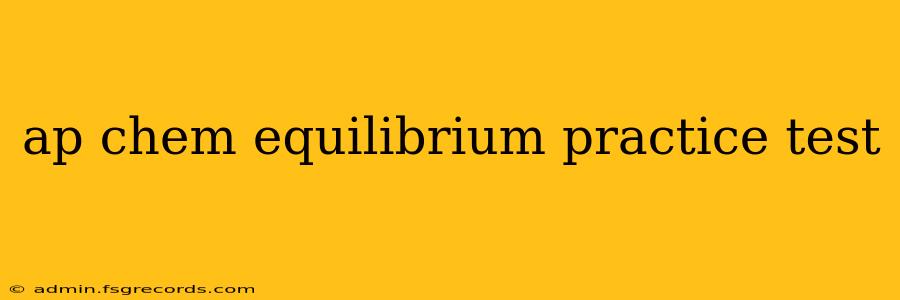Preparing for the AP Chemistry exam can be daunting, but mastering equilibrium is crucial for success. This comprehensive practice test will help you assess your understanding of equilibrium concepts and refine your problem-solving skills. Remember, consistent practice is key to achieving a high score.
Section 1: Multiple Choice Questions
Instructions: Choose the best answer for each multiple-choice question.
-
Which of the following statements is true regarding a system at equilibrium? a) The forward and reverse reaction rates are zero. b) The concentrations of reactants and products are equal. c) The forward and reverse reaction rates are equal. d) The reaction has stopped.
-
The equilibrium constant, K, for a reaction is a measure of: a) The speed of the reaction. b) The relative concentrations of reactants and products at equilibrium. c) The activation energy of the reaction. d) The enthalpy change of the reaction.
-
Le Chatelier's principle states that if a change of condition is applied to a system in equilibrium, the system will: a) Remain unchanged. b) Shift to increase the stress. c) Shift to relieve the stress. d) Shift to the side with fewer moles of gas.
-
Consider the reaction: N₂(g) + 3H₂(g) ⇌ 2NH₃(g). Increasing the pressure on this system at equilibrium will cause: a) No change in the equilibrium position. b) A shift to the left (towards reactants). c) A shift to the right (towards products). d) An increase in the equilibrium constant.
-
A reaction with a large equilibrium constant (K >> 1) indicates that: a) The reaction is slow. b) The reaction favors the reactants. c) The reaction favors the products. d) The reaction is irreversible.
-
What is the effect of adding a catalyst to a reversible reaction at equilibrium? a) It shifts the equilibrium to the right. b) It shifts the equilibrium to the left. c) It increases the equilibrium constant. d) It increases the rate at which equilibrium is reached.
-
The expression for Kc for the reaction: 2SO₂(g) + O₂(g) ⇌ 2SO₃(g) is: a) [SO₂]²[O₂] / [SO₃]² b) [SO₃]² / [SO₂]²[O₂] c) [SO₂][O₂] / [SO₃] d) [SO₃] / [SO₂][O₂]
-
What is the relationship between Kp and Kc for the reaction: N₂(g) + 3H₂(g) ⇌ 2NH₃(g)? a) Kp = Kc b) Kp = Kc(RT)² c) Kp = Kc(RT)⁻² d) Kp = Kc(RT)
-
Which of the following factors will not affect the equilibrium constant (K)? a) Temperature b) Pressure c) Concentration of reactants d) Catalyst
-
If the reaction quotient, Q, is less than the equilibrium constant, K, the reaction will proceed: a) To the left (towards reactants) b) To the right (towards products) c) To equilibrium instantaneously d) It will remain unchanged.
Section 2: Free Response Questions
Instructions: Answer the following free-response questions completely and show your work.
-
Consider the reaction: CO(g) + H₂O(g) ⇌ CO₂(g) + H₂(g) ΔH = -41 kJ/mol. Predict the effect on the equilibrium position for the following changes: a) Increasing the temperature. b) Decreasing the volume of the container. c) Adding more CO(g). d) Removing H₂(g).
-
At a certain temperature, the equilibrium constant, Kc, for the reaction: 2NO(g) + Cl₂(g) ⇌ 2NOCl(g) is 1.5 x 10³. If the initial concentrations are [NO] = 0.10 M, [Cl₂] = 0.15 M, and [NOCl] = 0 M, determine the equilibrium concentrations of all species. (Hint: Use an ICE table).
-
Explain the concept of the reaction quotient, Q, and how it relates to the equilibrium constant, K. What information does a comparison of Q and K provide about the direction a reaction will proceed?
This practice test provides a solid foundation for your AP Chemistry equilibrium studies. Remember to review the concepts thoroughly and practice more problems to strengthen your understanding. Good luck!

